人教版英语九年级第十单元教案
- 格式:docx
- 大小:26.76 KB
- 文档页数:13
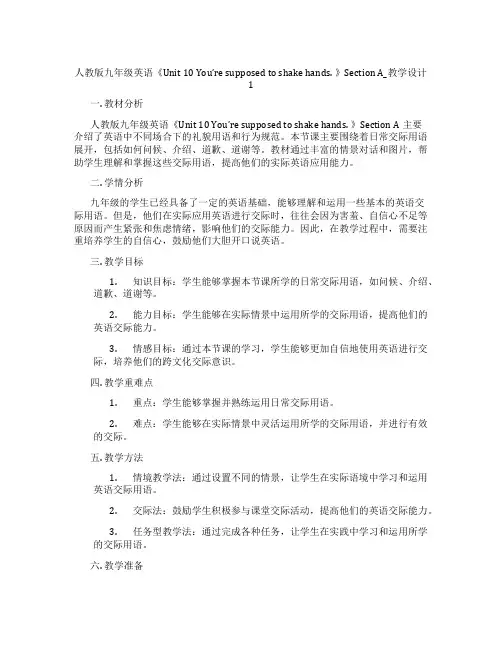
人教版九年级英语《Unit 10 You’re supposed to shake hands. 》Section A_教学设计1一. 教材分析人教版九年级英语《Unit 10 You’re supposed to shake hands. 》Section A主要介绍了英语中不同场合下的礼貌用语和行为规范。
本节课主要围绕着日常交际用语展开,包括如何问候、介绍、道歉、道谢等。
教材通过丰富的情景对话和图片,帮助学生理解和掌握这些交际用语,提高他们的实际英语应用能力。
二. 学情分析九年级的学生已经具备了一定的英语基础,能够理解和运用一些基本的英语交际用语。
但是,他们在实际应用英语进行交际时,往往会因为害羞、自信心不足等原因而产生紧张和焦虑情绪,影响他们的交际能力。
因此,在教学过程中,需要注重培养学生的自信心,鼓励他们大胆开口说英语。
三. 教学目标1.知识目标:学生能够掌握本节课所学的日常交际用语,如问候、介绍、道歉、道谢等。
2.能力目标:学生能够在实际情景中运用所学的交际用语,提高他们的英语交际能力。
3.情感目标:通过本节课的学习,学生能够更加自信地使用英语进行交际,培养他们的跨文化交际意识。
四. 教学重难点1.重点:学生能够掌握并熟练运用日常交际用语。
2.难点:学生能够在实际情景中灵活运用所学的交际用语,并进行有效的交际。
五. 教学方法1.情境教学法:通过设置不同的情景,让学生在实际语境中学习和运用英语交际用语。
2.交际法:鼓励学生积极参与课堂交际活动,提高他们的英语交际能力。
3.任务型教学法:通过完成各种任务,让学生在实践中学习和运用所学的交际用语。
六. 教学准备1.教学课件:制作课件,包括文本、图片、音频等素材,以便于教学展示。
2.教学道具:准备一些日常交际用语相关的道具,如名片、礼物等,以便于课堂操练。
3.教学资源:收集一些关于日常交际用语的视频素材,用于课堂拓展。
七. 教学过程1.导入(5分钟)利用学生日常生活中的一些交际场景,如问候、介绍等,引导学生思考和讨论这些场景下应该如何用英语进行交际。
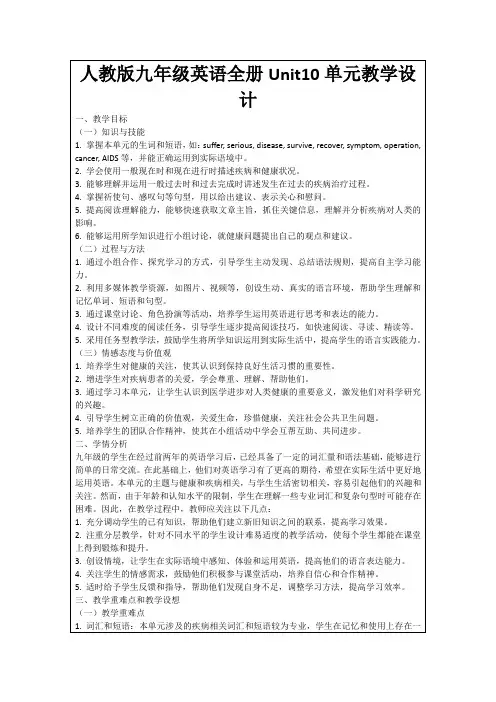
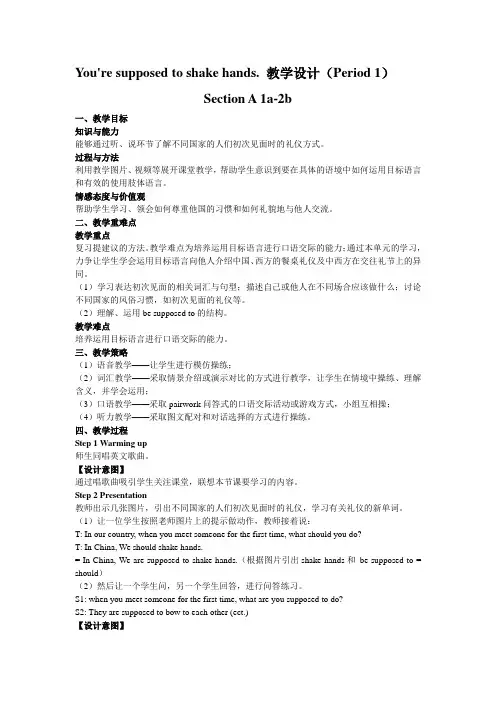
You're supposed to shake hands. 教学设计(Period 1)Section A 1a-2b一、教学目标知识与能力能够通过听、说环节了解不同国家的人们初次见面时的礼仪方式。
过程与方法利用教学图片、视频等展开课堂教学,帮助学生意识到要在具体的语境中如何运用目标语言和有效的使用肢体语言。
情感态度与价值观帮助学生学习、领会如何尊重他国的习惯和如何礼貌地与他人交流。
二、教学重难点教学重点复习提建议的方法。
教学难点为培养运用目标语言进行口语交际的能力;通过本单元的学习,力争让学生学会运用目标语言向他人介绍中国、西方的餐桌礼仪及中西方在交往礼节上的异同。
(1)学习表达初次见面的相关词汇与句型;描述自己或他人在不同场合应该做什么;讨论不同国家的风俗习惯,如初次见面的礼仪等。
(2)理解、运用be supposed to的结构。
教学难点培养运用目标语言进行口语交际的能力。
三、教学策略(1)语音教学——让学生进行模仿操练;(2)词汇教学——采取情景介绍或演示对比的方式进行教学,让学生在情境中操练、理解含义,并学会运用;(3)口语教学——采取pairwork问答式的口语交际活动或游戏方式,小组互相操;(4)听力教学——采取图文配对和对话选择的方式进行操练。
四、教学过程Step 1 Warming up师生同唱英文歌曲。
【设计意图】通过唱歌曲吸引学生关注课堂,联想本节课要学习的内容。
Step 2 Presentation教师出示几张图片,引出不同国家的人们初次见面时的礼仪,学习有关礼仪的新单词。
(1)让一位学生按照老师图片上的提示做动作,教师接着说:T: In our country, when you meet someone for the first time, what should you do?T: In China, We should shake hands.= In China, We are supposed to shake hands.(根据图片引出shake hands和be supposed to = should)(2)然后让一个学生问,另一个学生回答,进行问答练习。
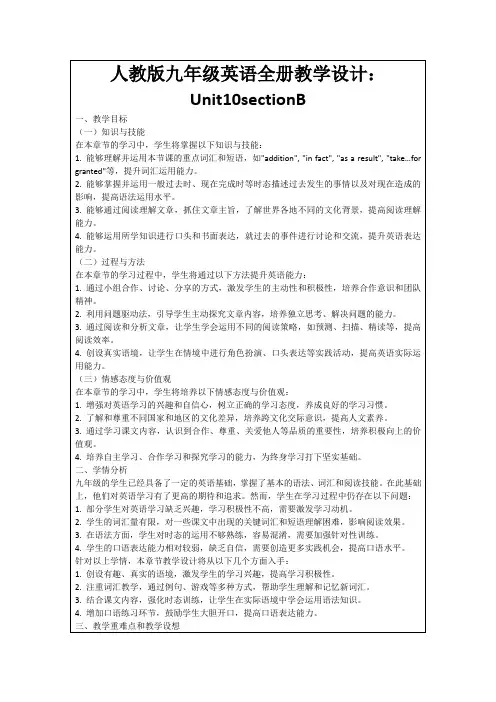
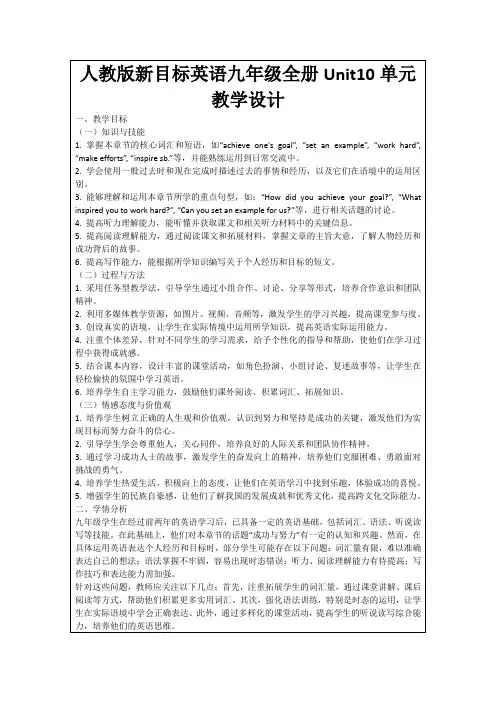
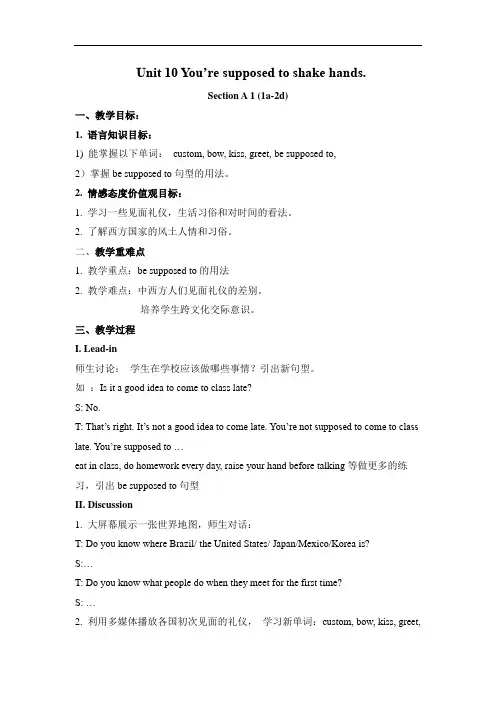
Unit 10 You’re supposed to shake hands.Section A 1 (1a-2d)一、教学目标:1. 语言知识目标:1) 能掌握以下单词:custom, bow, kiss, greet, be supposed to,2)掌握be supposed to句型的用法。
2. 情感态度价值观目标:1. 学习一些见面礼仪,生活习俗和对时间的看法。
2. 了解西方国家的风土人情和习俗。
二、教学重难点1. 教学重点:be supposed to的用法2. 教学难点:中西方人们见面礼仪的差别。
培养学生跨文化交际意识。
三、教学过程I. Lead-in师生讨论:学生在学校应该做哪些事情?引出新句型。
如:Is it a good idea to come to class late?S: No.T: That’s right. It’s not a good idea to come late. You’re not supposed to come to class late. You’re supposed to …eat in class, do homework every day, raise your hand before talking等做更多的练习,引出be supposed to句型II. Discussion1. 大屏幕展示一张世界地图,师生对话:T: Do you know where Brazil/ the United States/ Japan/Mexico/Korea is?S:…T: Do you know what people do when they meet for the first time?S: …2. 利用多媒体播放各国初次见面的礼仪,学习新单词:custom, bow, kiss, greet,III. Work on 1a-1c1.1a多媒体呈现1a图片,让学生根据图画内容,说说图中的握手,接吻,鞠躬是哪个国家的礼仪,然后按要求把书本给出的“国家”和“习俗”连接起来。
![九年级英语Unit10教案2(新人教版)_初三英[推荐五篇]](https://uimg.taocdn.com/67184228cd1755270722192e453610661fd95a45.webp)
九年级英语Unit10教案2(新人教版)_初三英[推荐五篇]第一篇:九年级英语Unit 10 教案2(新人教版)_初三英第二篇:九年级英语unit10教案教学目标1.学习一些公共场所的标志和说明,要能正确理解,规范自己的行为。
2.掌握本单元的词汇,特别是一些短语的用法。
3.进一步复习一些电话用语和电话对话中时态的综合运用。
4.进一步学习被动语态,特别是一般过去时态的被动语态谓语动词形式,它的肯定式、否定式、疑问式及其答语等。
5.认真学习“A visit to the Natural Museum”,掌握一些有关dinosaur的常识,丰富自己的背景知识。
6.能运用所学句型及语法结构来谈论某些物品的制作、产地和作用以及制成材料的日常用语。
Lesson 37Period: The First Period Content: Lesson 37 Properties: Recorder Teaching Objectives:1.Study the grammar: the Passive Voice in the past Simple Tense.2.Learn some new words and useful nguage Focus:on show, hundreds of, invent / invention Teaching Procedures:Ⅰ.OrganizingGreetings and make a duty report.Ⅱ.Revision1.check the homework.2.Revise the name of objects from the last unit and the Passive Voice: What's it made of? Where's it made? What's it used for? etc.Ⅲ.PresentationPresent the sentences:What's it made of?What's it used for?Then present the sentences:What was it made of?What was it used for?Ask students to compare with the groups sentences.Ⅳ.Listening.Part 1.Close books, listen to the tape and answer the questions.Where did Du Hui go yesterday?When were the old inventions on show invented?Play the tape again and make sure students can answer the questions correctly.Ⅴ.PracticeAsk some students to practice the dialogue.Then in groups and in pairs.At last let the students act it out.Ⅵ.Ask and answer Part 2.Ask the students to ask and answer in pairs according to the questions in the box.Ⅶ.PracticeAsk students to make sentences, and then change them into the Passive Voice in the past Simple T ense.Ⅷ.Workbook Do Exercise 1.Ask the students to read and complete the dialogue alone, then check the answers with the whole class.Do Exercise 2 in pairs.Ⅸ.Exercises in plete the dialogues Kate: Hello, Mary!This is Kate ________.Mary: ________ Kate.Kate: I ________ you yesterday, but you weren't ________.Mary: Oh, ________.I went to the Museum.Kate: Is it interesting?Mary: Yes, I saw many things ________ show.They were all ________ hundreds of years ________.Kate: Are there any new ________?Mary: Yes.Why not go there and have ________?Kate: That's a good idea.Ⅹ.HomeworkDo Exercise 3 in the exercise books.Make up a new dialogue.Lesson 38Period: The second period Content: Lesson 38 Properties: Tape recorder;picture Teaching objectives:1.Study the grammar: the passive voice in the Past Simple Tense.2.Learn some new words and useful nguage Focus:1.be interested in…2.on display3.be covered with4.in the 1920s' Teaching Procedures:Ⅰ.OrganizingGreetings.Ⅱ.Revision1.check the homework2.Revise the useful expressions and some new words.Ⅲ.PresentationTake out a picture and ask the students:What's this animal called?Ask some students to talk about the dinosaur.Ⅳ.Pre-reading Read over the questions with the students.Have the students guess the meaning of “on display” from the context.Then have the students discuss the questions in pairs.Ⅴ.Listening1.At first, ask students to read over the questions in the Exercise 1 in the workbook.2.Then close books and listen to tape.3.Play the tape again and answer the questions.Ⅵ.Teaching Language FocusExplain some useful expressions in the passage.1.be on a visit to…2.be interested in…3.try to do something4.be covered withe.g.He is on a visit to Shanghai.Tom is interested in English.I'll try my best to pass the exam.The ground was covered with snow.Ⅶ.Teaching Grammar1.Let the students find out these sentences with the Passive Voice in the Past Simple Tense.2.Have the students make sentences with the Passive Voice in the Past Simple Tense.Ⅷ.Workbook.Do Exercise 2 , and write down the answers.Ⅸ.Exercises in classChange the active sentences into the passive sentences:1.We bought a new TV last year.2.They didn't find the lost boy.3.My Uncle built a new house last year.4.My brother finished his homework yesterday.5.Dinosaurs laid the eggs long long ago.Ⅹ.Homework1.Read the passage.2.Finish off the workbook exercises.Lesson39 步骤1 复习1 检查家庭作业。

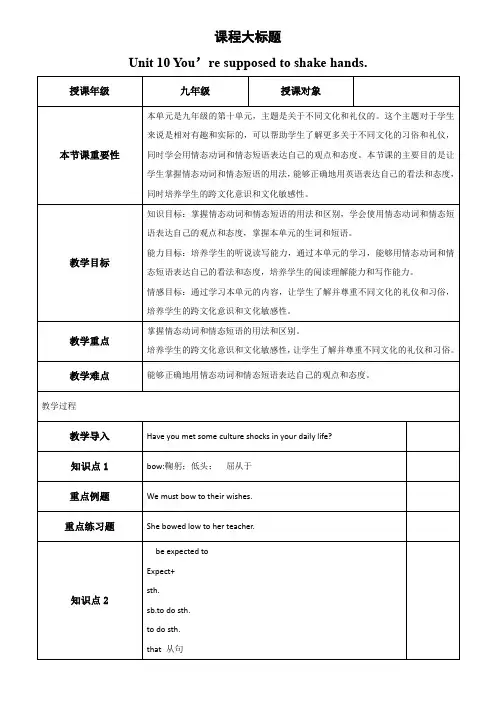
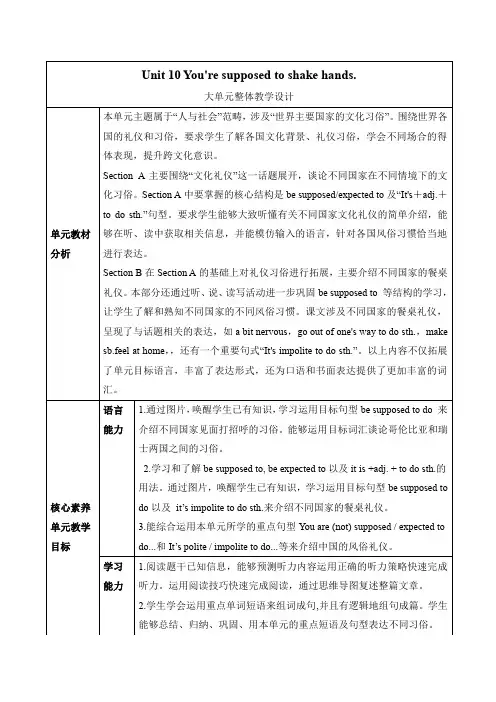
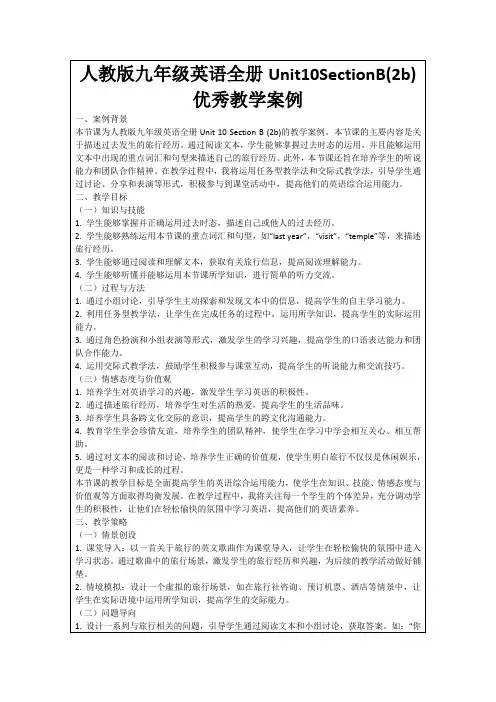
人教版新目标九年级英语教案Unit 10 You’re supposed to shake han d.Period 1 SectionA(1a-1c)Knowledge aims:(1)Key Vocabularybow, kiss, be supposed to, shake hands, customs(2) Target LanguageWhat are people in Korea supposed to do when they meet for the first time? They're supposed to bow.Ability aims:1. Train students' listening ability.2. Train students' communicative competence.Emotional aims:Before you meet foreigners, you should some customs. In this way, you can act politely and properly.Key points:Talk about customs and what you are supposed to do.Difficult points:Know about customs of different countries.Teaching methods:1.Scene teaching method2.Listening-and-answering activity to help the students go through with the listening material.Teaching tools:1.A tape recorder 2.PPT课件Teaching procedures:Step I: Review1.Yesterday we finished Unit 9. In this unit, we learned some ways of asking for information politely and express preferences.Make conversations with your friends.A: What kind of music do you like?B: I like music that ____________.2.Write your own sentence:I like music that________________________.I like musicians ________________________.Step II :New lesson1.Presentation:Step 1 1aThis activity introduces some target language.Let students read the instructions.Point to the two lists of words. Read each word and ask students to repeat it.Put up a map of the world on the board. Ask students to explain where each of the countries is.Suggested answers1.Brazil is in South America, next to Peru.2.The United States is in North America, next to Canada.3.Japan is in East Asia, to the east of China.4.Mexico is in North America, on the south of America.5.Korea is in East Asia. It is our neighbor.Look at the sample answer. Tell students to guess if they aren't sure. Answers1.c2.b3.a4.b5.aStep Ⅲ 1bThis activity gives students practice understanding the target language in spoken conversation.Play the tape for the first time. This time, students only listen.Play the tape a second time. Ask them to listen to the recording and check their answers to Activity 1a.Check the answers with the class. Invite a student to read the answers. Step Ⅳ 1cThis activity provides guided oral practice using the target language. Read the instructions to the whole class. Point out the example in the box. Ask two students to read it to the class.Step III:Practice:1. In Japan, the people are supposed to _________(鞠躬) when they meet for the time.2. It's not polite ____________(亲吻) the others in public in China.3. I was supposed to arrive at 8:00, but I (到达) at 9:00.4. When we meet Americans for the first time, we should_________(握手)with them.5. You must know some __________(习俗) before you go to some foreign countries.Step IV:summary:In this class, we've learned some important words, such as bow, kiss, be supposed to, shake hands. We've also learned the target language What are people in Korea supposed to do when they meet for the first time? They're supposed to bow.Step V:.homework:Review the target language.Bb design:Unit 10 You're supposed to shake hands.Section AThe First PeriodTarget Language:A: What are people in Korea supposed to do when they meet for the first time?B: They're supposed to bow.Period 2 SectionA(2a-2d)Knowledge aims:(1) Key V ocabulary :greet, be supposed to(2) Target Language: How was the dinner at Paul's house last night?Ability aims: 1. Train students' listening ability.2. Train students' communicative competence.Emotional aims: When you're invited to a place, you mustn't be late, greet people the wrong way and wear the wrong clothes. That is, you should act according to your host's customs.Key points:What are you supposed to do when you meet someone?Difficult points:How to improve students' listening ability.Teaching methods:1.Listening method to improve students' listening ability. 2.PairworkTeaching tools:1.A tape recorder 2.PPT课件Teaching procedures:Step I: ReviewCheck homework. Ask some pairs to act out their conversations according to Activity 1a.A: What are people in Mexico supposed to do when they meet for the first time?B: They're supposed to bow.Step II :New lesson1.(2a)This activity provides guided listening practice using the target language.Look at the picture and ask students to tell What is happening.Help students understand that the people are at a picnic.Read the instructions and point to the four mistakes on the list. Ask different students to read the mistakes to the class.Ask different students to explain the meaning of each line in their own words. Listen to Maria talking to a boy about what happened at the picnic. She made several mistakes. Listen to the recording and check the mistakes she made.Play the recording. Students only listen the first time.Play the recording again. Get students to check the mistakes Maria made. Check the answers with the class.Answers√ arrived late________ ate wrong food√ greeted Paul's mother the wrong way√ wore the wrong clothes2.(2b)This activity gives students practice in understanding the target language in spoken conversation.Go through the instructions with the class. Point out the blanks in the four sentences. Invite a student to read the first sentence.Play the recording again. Let students fill in the blanks with the words they hear alone.Correct the answers with the class.3.(2c)This activity provides guided oral practice using the target language. Read the instructions for the activity to the class.Look at the example in the box. Ask two students to read the conversation to the class.4.Role-Play conversationShow key points:expecte to do sthhold outTo one’s surpriseStep III:Practice:()1. Jim stood up and shook hands___ both of them.A.byB.withC.forD.to( )2. Chinese never bowed _________the enemiesA.inB.toC.onD.with( )3. John _______ Beijing the day before yesterday.A. arrived atB. arrivedC. reached toD. arrived in( )4. You ________stand in line when waiting for the bus.A. mustn’tB. can’tC. are supposed toD. don’t( )5. She _______some _______in her competition yesterday.A. has made; mistakesB. made; mistakesC. had made; mistakeD. was mistaking; mistakesStep IV:summary:In this class, we've learned key vocabulary greet and be supposed to, the target language How was the dinner at Paul's house last night? What are you supposed to do when you meet someone?Step V:.homework:Ask students to write at least two sentences with the key structure in this class.Bb design:Unit 12 Section A (2a-2d)1.Target Language:How was the dinner at Paul's house last night?2.What are you supposed to do when …You're … You're not …Period3 SectionA(3a-4c)Knowledge aims:(1) Key Vocabularyland, drop by, after all, relaxed, a bit(2) Target LanguageCan you tell me the things I'm supposed to do?Ability aims: 1. Train students' integrating skills.2. Train students' communicative competence.Emotional aims:Different countries have different customs. So you are supposed to do in Rome as the Romans do.Key points:Talk about customs and what you are supposed to do. Difficult points:Know about customs of different countries.Teaching methods: 1.Fast reading to let students get the general idea of the text. 2.PairworkTeaching tools:1.A tape recorder 2.PPT课件Teaching procedures:Step I: ReviewRevisionT: In last period, we summed up the expressions for telling what you are supposed to do. Now I'll check your homework. I'll ask some pairs to act out the conversations before the class.Step II :New lessonStep 1. 3aThis activity provides reading and writing practice using the target language.Show the key words on the screen by a projector.Cali n.卡利(哥伦比亚西部城市)Colombia n.哥伦比亚(南美洲西北部一国家)drop by 访问;拜访Lausanne n.洛桑(瑞士西部城市)Switzerland n.瑞士(欧洲中部国家)land n.国家;国土after all 毕竟Read the words and have students repeat again and again until they can pronounce the words fluently and accurately.Step2.3bRead the passage again and complete the chart.Look at the chart. Tell students what they will write in the chart.Check the answers.Step Ⅲ 3bThis activity provides guided oral practice using the target language.Go through the instructions for the activity with the class.Look at the example in the box. Ask two students to read the conversation to the class.First practice this conversation with a partner. Then talk about your attitude toward being on time and getting together with your friends. Step IV Grammar FocusReview the grammar box Get different students to say the questions and answers.Step III:Practice:be supposed to be expected tobe important to1.When you go abroad ,it __ bring your passport.2. After class,students____ clean the chalk off the blackboard.3.If you visit the northern coast of Norway during the winter season, it ___ pack warm clothes.4.If there are people in the meeting room, you_____ knock before entering.5.In many eastern European countries, you ___ take off your gloves before shaking hands.Step IV:summary:1.key vocabulary2.Grammar focusStep V:.Homework:Finish exercise 4b in the textbook.Bb design:Unit 10 You're supposed to shake hands.Section AThe Three PeriodTarget Language:A: What are you supposed to do when you meet someone for the first time?B: The first thing is ……Period4 SectionB(1a-1d)Knowledge aims:(1) Key Vocabularywipe, napkin, stick, chopstick, rude, point, pick up(2) Target LanguageWe're supposed to eat with chopsticks.Yes, and it's rude to eat with our hands.Ability aims: (1) Train students' ability to understand the target language in spoken conversation.(2) Train students' ability to use the target language.Emotional aims:In order to behave politely at the dinner table, you're supposed to learn some talbe manners.Key points:Target language.Difficult points:1.How to improve students' listening ability. 2.How to use the target language.Teaching methods: 1.Listening method 2.PairworkTeaching tools: 1.A tape recorder 2.PPT课件Teaching procedures:Step I: ReviewCheck homework. Get some students to read out their conversations using the target language in Section A 4c. Collect their conversations and help correct their errors.Step II :New lessonPart 1This activity introduces new vocabulary and provides reading practice using the target language.Look at the picture and ask students to say what is happening in it. (A family is eating a meal.)Look at the title, Mind your manners!Ask: What do you think it might mean?(It means be careful of how you act.)Read the instructions and point to the five statements about manners. Ask students to read the statements.Review the five statements to be sure students understand what each one means. Ask students to act out them. Then ask students to complete the quiz on their own.Part2.2aThis activity gives students practice in understanding the target language in spoken conversation.Read the instructions to the class. Review what an exchange student is and what table manners are. If necessary, translate them into Chinese. Play the recording the first time.Students only listen.Play the recording a second time. As they listen to the recording this time, let students number the pictures.Correct the answers with the class.Step Ⅳ 2bThis activity provides listening practice using the target language.Read the instructions and point to the numbered list of sentence starters and the lettered list of sentence endings. Ask different students to read the two lists.1.You aren't supposed to … a. to stick your chopsticks into your food. 2.It's impolite to… b. point at anyone with your chopsticks.3.You shouldn’t … c. start eating first if there are older people at the tableYou will hear the same recording again. This time as you listen, write the letter of the correct sentence ending after each sentence starter.Look at the sample answer. Read the correctly completed sentence to the class:Step Ⅵ SummaryIn this class, we've learned some key vocabulary, such as wipe, rude, point, pick up. We've also learned the target language by listening and speaking.Step Ⅶ HomeworkTalk about the table manners in your country using the sentence starters in Activity 1a.Bb design:Unit10 Period41.Sentences in Activity 2b:2.Target language:A: We're supposed to eat with chopsticks.B: Yes, and it's rude to eat with our hands.Period5 SectionB(2a-2b)Knowledge aims:(1) Key Vocabularytable manners, behave, be/get used to, cut up, full, fork, You should (2)Practice reading an article.Ability aims: (1) Train students' reading ability.(2) Train students' writing ability.Emotional aims:With the development of society, table manners are more and more important. Sometimes they can help people succeed. So you have to learn more table manners.Key points: Practice reading and writing using the target language. Difficult points:How to write an e-mail message.Teaching methods: 1.Reading comprehension to help students grasp the main idea of the text.2.Writing method 3.Groupwork to make every student work in class.Teaching tools: 1.A tape recorder 2.PPT课件Teaching procedures:Step Ⅰ RevisionReview the target language presented in this unit. Check homework. Ask two students to read out their sentences.SA: You aren't supposed to visited a friend's house without calling first. SB: It's polite to be on time.Step II :New lesson1.Ask and answer.What do you know about customs in foreign countries? What do you think is the biggest challenge when visiting a foreign country?2.2bThis activity provides reading practice using the target language. Teach the new words. Show the following new words on the screen by a projector.manner n. 礼貌;风格;习惯table manners 餐桌礼仪behave v. 行为表现;举止be/get used to 习惯于……cut up 切开;切碎fork n. 叉;餐叉full adj. 饱的;吃胀了的lap n. (人坐着时)腰以下到膝为止的部分;大腿elbow n. 肘;肘部gradually adv. 逐渐地;渐渐地compliment n. 称赞;恭维toast v. 敬酒Call attention to the e-mail message. Invite a student to read the article aloud to the class. Correct any pronunciation errors to make sure the student is providing a good model for the rest of the class.Now read the e-mail. Answer the questions in your exercise book. As students work, move around the classroom and offer help as necessary.Step 3.Read the sentences in 2c and replace the underlined words with the phrases in the box.1.Making mistakes in French used to make Lin Yue nervous.2.It was quite hard for her to feel good about speaking French.3.The host family tried very hard to help Lin Yue.4.Lin Yue has slowly learned how to be like her French friends.Step 4.Review the passage and make notes about French customs in the chart.This activity provides writing practice using the target language.Read the instructions and ask students to finish the exercise.Get students to finish the activity on their own. As students work, move around the room offering help as needed. Ask a student to read his or her message to the class. Have other students add any information that is missing from the first student's report.Step III: Practice:Your pen pal is coming to China on an exchange program. He/She is asking you about Chinese customs and what he/she is supposed to do or not. Make notes in the chart.Step IV: Summary:In this class, we've done a lot of reading, writing and speaking practice using the target language.Step V:Homework:Read the e-mail message in Activity 2b againBb design:Unit 12 You’re supposed to shake hands.Section B (2a-3a)1.What do you know about customs in foreign countries?2.Read the letter and answer the questions in 2b.Period6 SectionB (3b-selfcheck)Knowledge aims:1) Key Vocabularybe excited about doing sth 、some suggestions 、some advice、at the table (2) Target Language: You are supposed to …..You are not supposed to ….Ability aims: 1. Train students' writing ability.2. Train students' communicative competence.Emotional aims:Before you meet foreigners, you should obey some rules. In this way, you can act politely and properly.Key points:Talk about customs and what you are supposed to do. Difficult points:Write a short passage about table manners.Teaching methods: 1.Task-based teaching 2.PairworkTeaching tools: 1.A tape recorder 2.PPT课件Teaching procedures:Step I: Review1.manner n. _________2.table manners _________3.behave v. _________4.be/get used to _________5.cut up _________6.fork n. _________7.full adj. _________8.elbow n. _________9.gradually adv. _________pliment n. _________toast v. _________Step II: New lesson1.Talk about some table manners in China.2.Write a letter to your pen pal to give him/ her advice and suggestions on how to behave properly in China.This activity provides writing practice using the target language.Read the instructions and ask students to look back at Activity 2 Remind students that they made conversations about table manners in their own country.3.Writing practice.Dear Jenny.You must be excited about coming to China soon. Let me give you some suggestions and advice about Chinese customs. When you’re eatin g at the table. It’s impolite to stick your chopsticks into the food.In our house,you’re supposed to watch TV and play computers.When you go out with people, you should tell somebody who is home. Have a safe trip, and I look forward to meeting you soon!Best wishes.Step 3.Self check.1.Fill in the blanks with the words in the box.worth capital basic traffic empty mad knocking2.Think about your culture and make statements.In my culture, when you….You’re supposed to …..You’re not supposed to ……You’re expected to …….It’s impolite to …….It’s important to …..Step III: Practice:Have conversations with your partner.In my culture, you’re supposed to ….. you’re not supposed to …….. Step IV: Summary:In this class, we've done a lot of writing and speaking practice using the target language.Talk with your partners after class.Step V: Homework:Talk about the table manners in your country using the sentence in Self check.Bb design:Unit 10 You’re supposed to shake h ands.1. Write a letter to your pen pal to give him/her advice about table manners.2.Self check.。
Unit 10: You^re supposed to shake hands.Part 1: Teaching Design第一部分:教学设计Period 1: Matching,Listening and Speaking(What are people supposed to do...?)Objectives•To learn to understand and use supposed to + infinitive•To listen and speak what you are supposed to doProcedures■ Warming up by studying the title “Yoifre supposed to shake hands?9Hello, class・ Is there anyone who is late for school today? I see Li Jianshe is late・ He is not here yet. You have to be here for class before the bell ring・ That is to say you are supposed to be on time for school. By the way do you know what I mean by saying "you are supposed to be on time for school 二be supposed to...其中to是动词不定式符号,不是介词,其后要跟动词原形。
当be supposed to...的主语是“人”时,意为“应该……”;“被期望……”,它可以用來表示劝告、建议、义务、责任等,相当于情态动词should。
如:Everyone is supposed to wear a seat-belt in the car.每个人在汽车里都应该系安全带。
人教版九年级英语第十单元You are supposed to shake hands教案一、重点单词:1. custom 风俗、习俗2. bow 鞠躬3. greet 和…打招呼4. value 重视;价值5. everyday 每天的,日常的6. capital 首都7. mad 很生气,疯的8. traffic 交通9. somewhere 在某处10. passport 护照11. northern 北方的12. coast 海岸13. season 季节14. knock 敲,击15. worth 值得;有…价值的二、重点词组:1.be supposed to do sth被期望/要求做某事;应该2.shake hands握手3.drop by顺便拜访4.after all毕竟;终归5.pick up拾起;捡起接某人6.make a noise发出噪音7.table manners餐桌礼仪8.be relaxed about对…随意/放松9. get mad 大动肝火,气愤10.take off脱下(衣服);(飞机等)起飞11.make an effort作出努力12.be expected to do 被期待做… 13.as soon as一…就…14.on time 按时in time及时三、重点句式:1.In your country,what are you supposed to do when you meet someone for the first time?在你们国家,当你第一次见到某人的时候你应该做什么?--- You’re supposed to shake hands.--- You’re not supposed to kiss.2. When were you supposed to arrive?---I was supposed to arrive at 7:00.3. Am I supposed to wear jeans?---No, you’re expected to wear a suit and a tie.4. Is it impolite to keep others waiting?---Yes, it’s very impolite to keep others waiting.5. Is it important to be on time?---Yes, it’s important to be on time.四、语法:be supposed to do sth 被期望/要求做某事;应该知识点:1.In your country,what are you supposed to do when you meet someone for the first time?在你们国家,当你第一次见到某人的时候你应该做什么?【解析】be supposed to do sth被期望做某事,应该做......1)当主语是人时,表示劝告、建议、责任等,=should=“to be expected to do sth, You are supposed to___________(arrive)on time2)当主语是物时,表示“本应;本该” The train was supposed to arrive half an hour ago.You are supposed to________smoking,________you will get ill.A.go on;soB.give up;or C stop;so2.for the first time首先,第一次【辨析】at first/first of all(1)at first=at the beginning最初,开始【强调在时间顺序或做某事过程等开始之初】(2)first of all首先,第一【表明陈述事情的重要性】1.When you want to work for our country in the future,____,we should have strong bo dy and rich knowledge.A.at firstB.first of allC.for the first timeD.after all2.Do you remember the day when we met for the___time?A.firstB.oneC.onceD.firstly3.You’re supposed to shake hands你应该握手。
九年级全册Unit 10Section A (3a-3c)教学设计一、教学目标:1. 语言知识目标:1) 学习掌握下列词汇:relaxed, value, capital, noon, mad, effort, drop by, after all,get mad, make an effort2)复习be supposed to句型。
3)如何正确的阅读课文。
2. 情感态度价值观目标:1)通过“应该” 与“不应该”进一步了解一些国家的礼仪和对时间的看法。
2)了解不同国家的不同的时间观念,加强对中国文化的理解。
二、教学重难点1. 教学重点:1) 掌握本部分出现的生词和词组,达到熟练运用的目标。
2) 阅读短文,获得相关的信息。
通过阅读练习,来提高阅读能力。
2. 教学难点:1) 阅读短文,获得相关的信息的能力。
2) 理解并运用所学的词汇及表达方式。
三、教学过程Ⅰ. RevisionDifferent countries different customs.e.g. A: What are people supposed to do when they meet in...?B: They are supposed to bow / kiss / shake hands....Ⅱ. Warming upAre you supposed to be on time when you meet your friends?Are you supposed to call your friends before you go to their house for dinner?Are you supposed to make plans to meet your friends?But people in other countries may have different opinions. Let’s take two of them as examples.Ⅲ.Lead-in1. 展示一个哥伦比亚和瑞士风光的照片。
人教版九年级英语unit 10教学设计【教材版本】人民教育出版社九年级英语【学习内容】grammar focus, 3a, 3b and 4 of unit 9 when was it invented ?【学情分析】本节课是第九单元的第二课时, 学习任务是完成课文grammar focus, 3a, 3b and 4 部分的学习。
本单元要求学会谈论重要发明的历史及用途,然后针对各项发明的用处及特点,发表自己的看法,并说明理由。
话题一直是围绕着历史上和日常生活中的重要发明,通过使用“passive voice”形式的句型,循序渐进地展开讨论。
课本设计的活动情景能够自然地引发学生的好奇心,大家积极地投入到话题讨论中,寓教于乐,容易引起学生的兴趣;同时,它也有利于开阔学生的思路,培养创造精神,展开丰富的想象力,人人都能成为“小发明家”。
学生在第一课时学习了本单元的section a 中的1a至2c部分,基本能听懂、会说本单元要求掌握的部分重要词汇;在图片,相关信息等提示的帮助下,能较好地运用重要句型和掌握主动语态和被动语态及相互转换。
但是本班的学生两极分化比较严重,有一部分学生基础知识不牢固,前面提到的学过的单词和句型就忘得差不多了,特别是对于课文中的语法—主动语态和被动语态,被动语态的一般现在时和一般过去时混为一谈。
所以教师在课堂教学中应面向整体,及时复习相关的知识,包括重要词汇和句型,前后知识的衔接。
同时在设计上要注意活动的多样性,激发他们的兴趣,让每一位学生能得到不同程度的收获。
【单元整体目标】重点词汇:salty, sweet, sour, crispy, pleasant, potato chips, slipper, leaf, fire, scoop, light bulb, microwave oven, abacus, camera, beverage, be invented by, be used for, by mistake, by accident重点句型:when was the telephone invented? i think it was invented in 1876.技能目标:能够谈论发明的历史和用途。